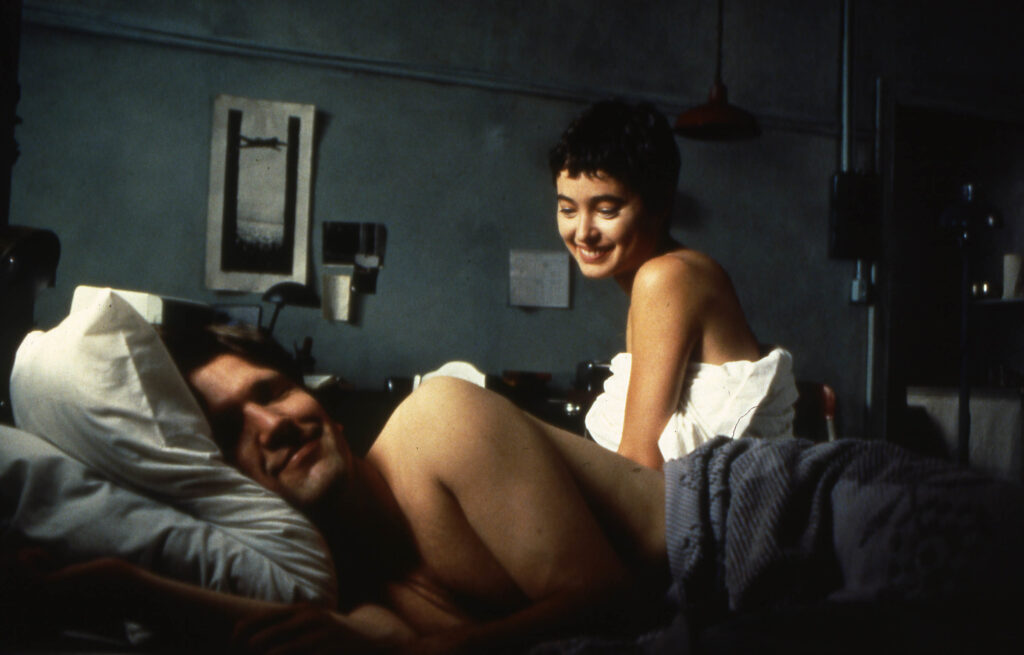
Surviving Desire (1992) deals with the intelligentsia, and the inherent problems of a relationship between an older man and a younger woman. However, Hartley’s older man, Jude (Martin Donovan), isn’t so much older than the woman he pursues, Sofie (Mary B. Ward), since he seems emotionally stunted. Anyway, Hartley doesn’t need a large age gap to dramatize the verboten affair; Jude is Sofie’s professor.
Hartley permits his characters the intelligence to scrutinize themselves directly and openly in dialogue exchanges that are void of the typical heavy cultural referencing one sees in most comedies’ dialogue. Instead focus is primarily on either the mundane or the emotional turmoil of the characters, and even in some scenes there is a balance between the two. Hartley allows the characters in his film to trust one another, and to exchange healthy doses of criticism (Jude has no qualms about admitting what a terrible teacher he is). That does not necessarily make Hartley’s characters less intelligent or interesting. The sort of referencing one sees in other comedies is relegated to situational motivation (Jude discusses books only in a bookstore), and therefore allows a naturalist tendency to the film. Though, such a tendency is superficial to the film’s construction, it remains a more matured or perhaps learned employments of the referential device.
Hartley pushes Jude’s self-reflection to the unreal comedic extremes one sees employed in comedies from the seventies (Harry & Walter Go To New York, Paper Moon, Shampoo, etc). In one scene, following Jude’s romantic fulfillment with Sofie, he walks into an alley and dances, and as the dance progresses, other “happy” men join Jude (this tactic will be adapted quite successfully by John Turturro for Romance & Cigarettes). So it soon becomes clear that Surviving Desire, though it depends on several varieties of genre mechanics, is a subjective document of Jude’s romantic relationship with Sofie going from start to finish.
Hartley balances the film with a strong female counterpart to Jude, and will even relent in his subjective portraiture to empower Sofie. There are a handful of scenes in Surviving Desire in which Sofie and her roommate/girlfriend evaluate Jude and harshly criticize or even make-fun of him behind his back. Hartley’s ability to empower Sofie this way also makes for a comic counterpoint to the hopelessly in love Jude. In this way, it is easier to laugh at Jude, as opposed to simply feeling sorry for him, or disgusted by him, and rejecting him based on his obsessive behavior.
It’s a very careful juggling act of themes and styles in Hartley’s film, pointing to a matured understanding of his material and the genre in which it is presented. He is aware of the clichés someone like Mike Nichols or James L. Brooks has established and the trap of imitating other filmmakers working with the same class of intelligentsia (such as Whit Stillman). By diversifying the mechanics of Surviving Desire Hartley manages to re-invigorate this kind of romantic comedy, giving it a fresh dimension that eludes audience expectations so that the film stays engaging.
Upon discussing the formalist executions in Surviving Desire, it seems best to address the bigger picture. Hartley’s film is quite short, just over eighty minutes, and stands more as a transitional film between his early features and those that would follow Surviving Desire. But to label Surviving Desire as nothing other than an exercise in manipulating film constructs would be unfair. The film contains fewer narrative threads than Hartley’s earlier films; it has a fresh and mature execution, dealing with more mechanical issues within the genre than either Trust or Unbelievable Truth.
